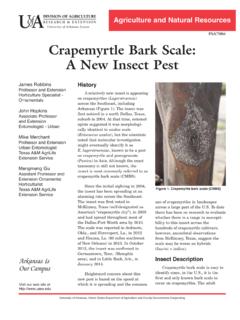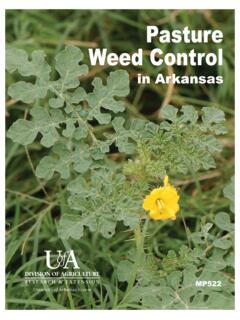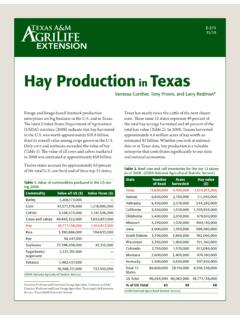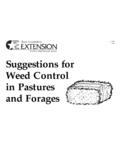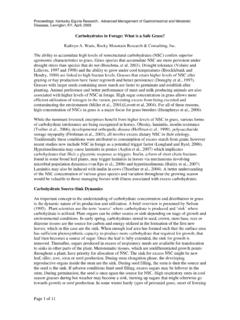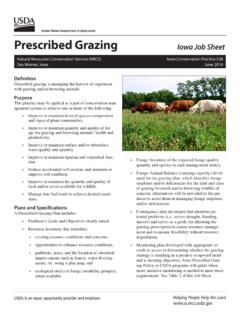Transcription of Seed Production of Tall Fescue - FSA3049 - uaex.edu
1 Agriculture and Natural ResourcesDIVISION OF AGRICULTURE RESEARCH & EXTENSION University of Arkansas System FSA3049 seed Production of tall Fescue John Jennings Professor -Animal Science Arkansas Is Our Campus Visit our web site at: tall Fescue seed Production in the U. S. is concentrated primarily in Oregon and Missouri. Most certified and proprietary cultivar seed produc tion comes from Oregon. seed grown in Missouri and surrounding states, including Arkansas, goes mainly to the turfgrass market. Most Fescue in Arkansas is the endophyte-infected KY-31 cultivar.
2 Many Arkansas producers view a Fescue seed crop as a bonus to their livestock operation. Fescue seed yields in Arkansas average 180 to 200 pounds per acre. Average seed yield is low because fields are managed mainly for producing livestock forage instead of seed Production . Yields of 400 to 600 pounds of seed per acre can be produced by using improved management prac tices. seed yields as high as 1,000 pounds per acre have been reported. In Oregon, the average seed yield is about 1,100 pounds per acre, and yield can be as high as 1,800 to 2,000 pounds per acre. There Fescue is grown in rows, and the climate is ideal for seed Production and harvest.
3 In Arkansas, hot tem peratures, late spring thunderstorms and high humidity are challenges for producing a high-yielding seed crop. The Fescue seed market is widely variable. In some years, the price of Fescue seed at harvest time may be extremely attractive while seed prices the next year may be extremely depressed. Farmers who anticipate producing a Fescue seed crop should first locate Fescue seed buyers and check on market demand. Fescue seed Production Management Practices seed yield is determined by three factors: Number of reproductive tillers per acre Seeds per tiller Weight per seed Of those factors, the main one that can be influenced by management is the number of reproductive tillers per acre.
4 The number of seed per tiller and weight per seed are more dependent on temperature and moisture conditions at flowering and during seed fill than on producer management. Two management practices are critical to increase the number of repro ductive tillers for high seed yields: Clipping Fescue residue soon after the seed stalks are mature or the seed crop is harvested. The application of nitrogen fertilizer during the very late fall or winter. Effect of Clipping After seed Harvest on seed Yield Clipping or mowing the Fescue stubble for hay after seed harvest is necessary for the development of new tillers.
5 Sunlight penetration into the canopy stimulates basal crown bud University of Arkansas, United States Department of Agriculture, and County Governments Cooperating development. Reproductive tillers that are responsible for the following year s seed crop grow from those basal buds. The most active bud development period is July to October. Tillers grown during fall are far more likely to produce seedheads than tillers produced during spring. A short-day and cold-temperature stimulus is required for a tiller to produce a seedhead. Research has shown that 75 percent of fall-produced tillers pro duced seedheads the following year, but less than 10 percent of tillers that emerged in February or March produced seedheads.
6 To promote tiller development, Fescue stubble should be clipped to a height of 3 to 4 inches immedi ately after harvesting the seed crop. Fields of tall Fescue not harvested for seed the previous year but designated for seed Production the next year should be clipped by the time the seed stalks are mature. It is best to remove the residue if possible. Failure to clip and remove the stubble can reduce the following year s seed crop by 40 to 45 percent. Effect of Fertilization and Nitrogen Timing on seed Yield Timing and rate of nitrogen fertilization has a positive effect on seed yield.
7 Fields managed for seed Production should be topdressed with 70 to 100 pounds per acre of nitrogen during December or January. If seed fields will be grazed in fall and winter, nitrogen fertilizer can be applied at a rate of 40 to 60 pounds of nitrogen per acre in late August to early September. This application timing promotes forage growth for fall grazing and increases potential tillers for seed yield the following year. An additional 40 to 60 pounds per acre of nitrogen should be applied in December or January for seed Production . Nitrogen applied in February or March influences leaf growth more than seed Production and may cause excessive vegetative growth and lodging, which negatively affect seed yield.
8 Phosphorus and potassium levels should be maintained at least in the medium range of soil fertility based on current soil test results. Potassium fertility is especially important when forage residue is baled and removed after seed harvest. Fescue hay removes large amounts of potassium, which must be replaced by proper fertilization to maintain forage and seed yield. Managing for Forage and seed Production Since most Fescue fields used for seed Production are grazed during the fall or winter, cattle manage ment becomes an important factor. seed Production may decline after a few years on solid stands that are not grazed due to a condition known as sod-bound.
9 This is associated with thickening of the stand, which causes competition for new tillers. Skim-plowing can reduce this problem. Solid stands of Fescue grazed during the fall do not show this decline in Production . Fall grazing results in greater tillering because of greater light penetration into to plant crowns. To maxi mize seed Production , fields should only be lightly or moderately grazed during September, October and November. After November, grazing pressure may be increased so the forage is removed by January or February. Cattle should be removed from seed fields by March 1 to prevent grazing of new seed -producing stems.
10 Grazing too late after spring greenup will reduce seed yield. Fescue seed Harvest Fescue seed may be harvested by direct combining or Fescue may be mowed, windrowed and then com bined. Fescue seed is mature when the straw in the head turns yellow, but moisture content will be too high for direct harvest with a combine. Excessive seed moisture will cause heat ing during storage, weaken seed vigor and cause poor germination. Direct combining can usually begin when the straw is yellow about 6 inches below the seedhead. About 5 to 15 percent of the seeds may be immature at this stage.






